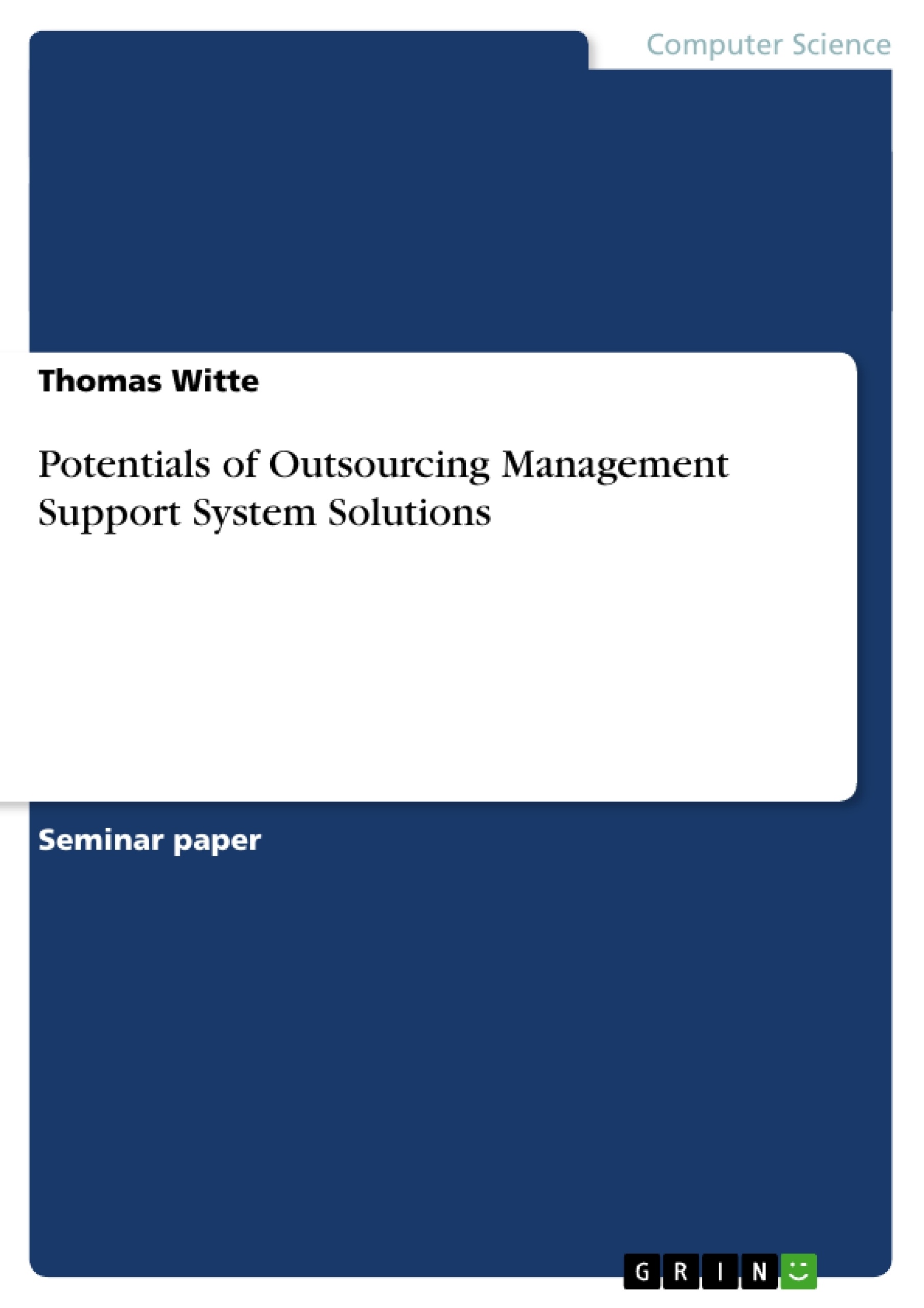Extracto
Table of Contents
Table of figures
List of abrevations
1 Introduction
1.1 Preamble
1.2 Proceeding structure
2 Basics
2.1 Management Support Systems
2.2 Outsourcing
3 Outsourcing MSS-Solutions
3.1 Possible forms of Outsourcing MSS-Solutions
3.1.1 Organisation
3.1.2 Technology
3.2 Chances of Outsourcing MSS-Solutions
3.2.1 Financial Aspects
3.2.2 Strategical Aspects
3.3 Risks of Outsourcing MSS-Solutions
3.3.1 Financial Aspects
3.3.2 Strategical Aspects
4 Conclusion
Bibliography
Table of figures
Fig. 1.: Outsourcing
according to: Allweyer , T., Schaaf, J., Besthorn, T.: IT-Outsourcing: Zwischen Hungerkur und Nouvelle Cuisine, DB Research: Frankfurt 2004 Online: http://www.dbresearch.de/PROD/DBR_INTERNET_DE-PROD/PROD
00000073793.PDF retrieved: (08.10.05) p
Fig. 2.: Service categories of outsourcing
according to: Fröschl, F.: Vom IuK-Outsourcing zum Business Process Outsourcing, in: Wirtschaftsinformatik Vol. 41 (1999) 5 p.458-460, p
List of abrevations
Abbildung in dieser Leseprobe nicht enthalten
1 Introduction
1.1 Preamble
“Efficiency” is the buzzword for a competitive company [Meckl 99, p.7]. This especially is a topic for the secondary activities of the value creation chain. The value of Management Support, as part of the intern services of an enterprise, is hard to numeralise.
For this reason ‚Outsourcing’ is a big issue. Services and infrastructures which are not one of the enterprise’s core businesses are placed to third party providers.
“Do what you can do best – outsource the rest!” is a familiar quotation that emphasizes to concentrate on core activities.
From the economical point of view the factor of minimizing costs is a main reason for deriving single tasks from an enterprise. Bigger Outsourcing-Projects have to be in line with the strategical orientation of the enterprise.
The present paper focuses on the potentials of Outsourcing Management Support System (MSS) Solutions. Different forms of Outsourcing are examined and their feasibility is discussed. Information is a sensitive resource. The question is how MSS-Solutions qualify for outsourcing-projects.
1.2 Proceeding structure
The second chapter tries to describe the key words ‘Management Support Systems’ and ‘Outsourcing’. The attempt for an universal valid definition is being made here.
Chapter 3 takes a look at the reasons of outsourcing MSS-Solutions. Which conditions have to be fulfilled for a reasonable outsourcing of MSS-Solutions? To answer this question it is necessary to take a closer look at the reasons of outsourcing in general. Chapter 3.1 tries to answer the question: Which forms of outsourcing are possible for MSS-Solutions? The pros and cons of outsourcing MSS-Solutions are discussed in chapter 3.2 and 3.3.
Chapter 3.2 enumerates the chances of outsourcing and chapter 3.3 gives a general survey about the risks of outsourcing especially of MSS-Solutions.
The present paper closes with an attempt of recommendation for possible outsourcing ambitions.
2 Basics
2.1 Management Support Systems
Management Support Systems are used to support management with information. An early definition is given by Scott Morton in the 1980s. He describes Management Support Systems as “[…] the (combined) use of information and communication technologies to support managers" [Scott Morton 83].
‘Management Support Systems’ is a term of wide comprehension for technologies used to gather information and to bring them into a suitable form for an easier interpretation by users [Gluchowski et al. 97, p.149 ff]. It refers to a “[…] collection of computerized technologies whose objective is to support managerial work and especially decision making, including terminology and overview of the decision-making process” [Turban 95, p.1].
The level of productivity, or the success of management, depends on the execution of certain managerial functions like planning, organizing, directing, and controlling. Managers are engaged in a continuous process of decision making [Gluchowski et al. 97, p.11 ff].
Information systems can provide value-added computing power to the execution of critical tasks and to the business of reengineering. Computer applications are moving from transaction processing and monitoring activities (which dominated the industry in the 1960s and 1970s) to problem analysis and solution applications in the 1990s. Managers are provided with information systems that can assist them in their most important task – decision making [Turban 95, p. 4 f]. Many Software Systems can be subordinated to this vague description. There is a large number of acronyms like EIS, MIS, DSS and it is hard for the user to recognize classifications among them. Gluchowski et al. try to classify these Systems by arranging them under four dimensions [Gluchowski et al. 97, p. 142 ff]:
1. System environment, which determines the problem to solve and the given organisation with it’s planning and decision making structures.
2. System assembly, which defines system components of an MSS and the technologies and architectures of the system.
3. System arrangement, which refers to the whole engineering process of an MSS under different approaches.
4. System use, which determines the way of utilisation.
The data management of larger enterprises often consists of several operational databases. To consolidate them into one and use the data as base for analyses they are concentrated. Often these ‘buildings’ created by ETL-tools are called Data Warehouses. Data Warehouses try to supply the user with actual and consistent information. Relational databases often proof to be not flexible enough to fulfil the duties of Data Warehouses and the reporting systems which are based on them.
“A data warehouse is a: subject-oriented, integrated, timevariant, nonvolatile collection of data in support of management's decision making process” [Inmon 95].
OLAP is an acronym for online analytical processing. It is an approach to provide the result to complex database queries quickly. Beyond the basic concept there are three types of OLAP - multidimensional OLAP (MOLAP), relational OLAP (ROLAP), and hybrid OLAP (HOLAP).
2.2 Outsourcing
‘Outsourcing’ is a relatively young term. Generally ‘Outsourcing’ means receiving goods and services form third party service providers. Outsourcing and out-tasking involve transferring a significant amount of management control to the supplier [Lux / Schön 97, p. 3]. Likewise, buying services from a provider is not necessarily out-sourcing or out-tasking. Outsourcing always involves a considerable degree of two-way information exchange, co-ordination, and trust.
[...]
- Citar trabajo
- Thomas Witte (Autor), 2005, Potentials of Outsourcing Management Support System Solutions, Múnich, GRIN Verlag, https://www.grin.com/document/48974
Así es como funciona






















Comentarios